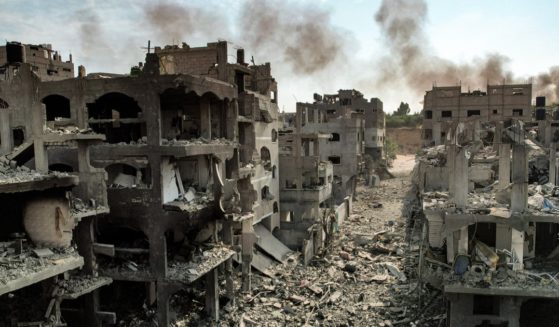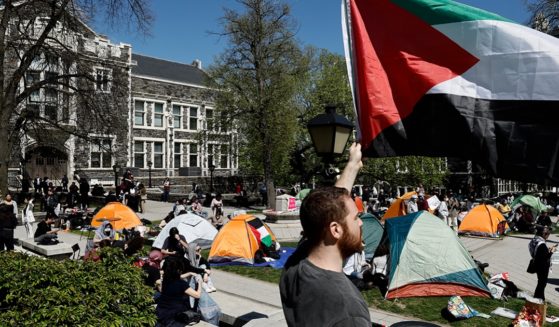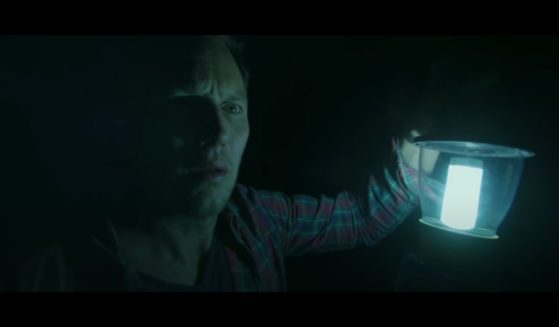Israel Considers Tearing Up Ancient Christian Mosaic Near Armageddon, Sparking Backlash
An ancient Christian mosaic bearing an early reference to Jesus as God is at the center of a controversy that has riled archaeologists: Should the centuries-old decorated floor, which is near what’s believed to be the site of the prophesied Armageddon, be uprooted and loaned to a U.S. museum?
Israeli officials are considering just that.
The proposed loan to the Museum of the Bible in Washington also underscores the deepening ties between Israel and evangelical Christians in the United States.
The Megiddo Mosaic is from what is believed to be the world’s earliest Christian prayer hall, located in a Roman-era village in northern Israel. It was discovered by Israeli archaeologists in 2005 during a salvage excavation conducted as part of the planned expansion of an Israeli prison.
The mosaic bears Greek inscriptions, among them an offering “To God Jesus Christ.”
The prison sits at a historic crossroads a mile south of Tel Megiddo on the cusp of the wide, flat Jezreel Valley. The compound is ringed by a white steel fence topped with barbed wire and is used for the detention of Palestinian security inmates.
Across a field strewn with cow dung and potsherds, the palm-crowned site of a Bronze and Iron Age city and ancient battles is where many believe a conclusive battle between good and evil will transpire at the end of days: Armageddon.
“Megiddo” is mentioned several times in the Bible’s Old Testament, and the New Testament refers to “Armageddon” once in reference to the end times. Revelation 16:13-16 says:
And I saw, coming out of the mouth of the dragon and out of the mouth of the beast and out of the mouth of the false prophet, three unclean spirits like frogs. For they are demonic spirits, performing signs, who go abroad to the kings of the whole world, to assemble them for battle on the great day of God the Almighty. (“Behold, I am coming like a thief! Blessed is the one who stays awake, keeping his garments on, that he may not go about naked and be seen exposed!”) And they assembled them at the place that in Hebrew is called Armageddon.
The Israel Antiquities Authority said that it will decide about the mosaic move in the coming weeks following consultations with an advisory body.
“There’s an entire process that academics and archaeologists are involved with,” IAA director Eli Eskozido said.
The organization said moving the mosaic from its original location was the best way to protect it from upcoming construction at the prison.
Jeffrey Kloha, the Museum of the Bible’s chief curatorial officer, said a decision on the loan would be made solely by the IAA.
The museum “of course would welcome the opportunity to educate our thousands of visitors on important pieces of history such as this mosaic,” he told The Associated Press via email.
Several archaeologists and academics have voiced vociferous objections to the notion of removing the Megiddo Mosaic from where it was found.
Others balk at the thought of moving the mosaic at all before an academic study is complete.
“It is seriously premature to move that mosaic,” said Matthew Adams, director of the Center for the Mediterranean World, who is involved in digs at Tel Megiddo and the abutting Roman legionary camp of Legio.
The Washington museum was criticized for its early acquisition practices and issued a statement in 2020 committing to do better.
Asked about its past mistakes by the AP, Kloha said, “Major museums and distinguished institutions committed to preserving history have had to grapple with cultural heritage issues, particularly in recent years.”
“To be clear: Museum of the Bible is proud to have proactively launched research and a thorough review of items in its collections,” he said. “The museum initiated returns where appropriate to countries of origin without obligation to do so and encourages other institutions to do the same.”
Based on other finds found in the dig and the style of the letters in the inscriptions, IAA archaeologists have dated the mosaic floor to the third century — before the Roman Empire officially converted to Christianity and at a time of great persecution.
Nonetheless, one of the donors who paid to decorate the ancient house of worship was a centurion serving in the adjacent Roman legionary camp.
The mosaic loan would reinforce ties between Israel and the museum. The museum sponsors two archaeological digs in Israel and has a gallery curated by the IAA. Kloha said the museum also is planning a lecture series featuring IAA archaeologists.
The Megiddo Mosaic could be loaned to Museum of the Bible in Washington. It was discovered by Israeli archaeologists in 2005 during a salvage excavation conducted as part of the planned expansion of an Israeli prison.
The IAA said that it will decide about the move in the coming… pic.twitter.com/VHt440tuQp— Ticia Verveer (@ticiaverveer) August 15, 2023
Evangelicals, who make up more than a third of the world’s estimated 2 billion Christians, have become some of Israel’s most fervent supporters. Their affinity for Israel stems from Christianity’s Jewish roots.
Since its discovery, the mosaic has remained buried beneath the grounds of the Megiddo Prison. But in recent years, the Israeli government has started advancing a multiyear plan to move the prison from its current location and develop a tourist site around the work.
The Tel Megiddo archaeological site is already a major attraction for evangelical Christians visiting the Holy Land. Busloads of pilgrims stop on their way to or from Galilee to see the ruins of a biblical city and pray at the site where they believe the apocalypse will take place.
Neither the IAA nor the museum would discuss the exact terms of the loan proposal, but Eskozido suggested something similar to the decade-long global tour of a Roman mosaic found in the central Israeli city of Lod until Israel had completed a museum to house it.
Some experts remain skeptical of uprooting the mosaic.
“Once you take any artifact outside of its archaeological context, it loses something, it loses a sense of the space and the environment in which it was first excavated,” said Candida Moss, a theology professor at the University of Birmingham who co-wrote a book about the Museum of the Bible.
Rafi Greenberg, a professor of archaeology at Tel Aviv University, said archaeological finds “should stay where they are and not be uprooted and taken abroad to a different country and basically appropriated by a foreign power.”
Associated Press religion coverage receives support through the AP’s collaboration with The Conversation US, with funding from Lilly Endowment Inc. The AP is solely responsible for this content.
The Western Journal has reviewed this Associated Press story and may have altered it prior to publication to ensure that it meets our editorial standards.
Truth and Accuracy
We are committed to truth and accuracy in all of our journalism. Read our editorial standards.












